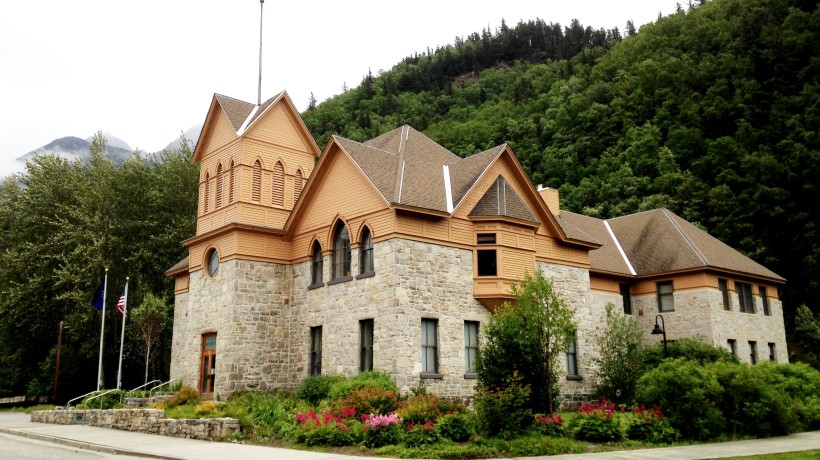 If proposed changes in the Haines interim borough manager’s budget are approved, the town could see an expanded police force, a new strategy for economic development and a slight mill rate increase. Brad Ryan released his fiscal year 2018 spending plan Friday. Ryan says he created a budget that looks beyond the status quo and forges a new direction for the borough.
If proposed changes in the Haines interim borough manager’s budget are approved, the town could see an expanded police force, a new strategy for economic development and a slight mill rate increase. Brad Ryan released his fiscal year 2018 spending plan Friday. Ryan says he created a budget that looks beyond the status quo and forges a new direction for the borough.
Part of that new direction is giving the Haines Police Department more resources to address local alcohol and drug abuse issues. Ryan frames his proposal to increase the police budget with that goal in mind. He also hopes it will cut down on systematic turnover.
The boosted police budget reverses the direction former manager Dave Sosa took in 2015. In response to state budget cuts, Sosa downsized the police force from five to four officers.
A new police chief, Heath Scott, took over midway through 2016. In recent months, he made his case to the public safety commission and assembly to restore that fifth officer position that was eliminated less than two years ago.
Ryan heeded Scott’s request in his spending plan. Adding a fifth officer raises expenses by $54,000. That may not seem like much of a change, but the police budget has already increased by about $100,000 during this fiscal year.
The borough originally allocated $520,000 for the police department last June. That number eventually inflated to $618,000. It’s partly due to increased salaries from a new bargaining agreement and Chief Scott’s $15,000 in moving expenses. The most significant factor in the increase is a $63,000 budget amendment the assembly recently approved to cover unanticipated costs, including overtime.
To offset the cost of police expansion, Ryan suggests trimming personnel expenses where possible. He proposes not filling a part-time office assistant job in the admin building. He also restructured the public works department following the retirement of long-time superintendent Ralph Borders.
Now, the superintendent also serves as a mechanic, which used to be a separate position. Ryan also proposes not filling an operator job he expects to become vacant soon. In its stead, He says the public facilities director could maintain a commercial driver’s license and fill in as a plow operator when needed. The shifting of public works duties saves about $20,000.
Ryan also proposes a small townsite property tax increase to raise revenue. Townsite rates would go up by 0.1 mills, from 10.47 to 10.57. That equals a $10 increase for every $100,000 worth of property.
Another significant change in the budget is Ryan’s plan for the one percent sales tax dedicated to tourism and economic development. In his budget last year, Ryan eliminated a borough economic development director position. Now, he proposes using the sales tax income for a different approach: an economic development corporation. The newly-formed HEDC asked the borough for $95,000, which Ryan includes in his plan. The money for the private corporation is likely to be a topic of debate as the assembly combs through the budget.
Meanwhile, Ryan decreases tourism spending by about $50,000. He says much of that cost saving comes from a new online marketing platform.
The budget stays status quo when it comes to school funding. Ryan offers the same amount of borough funding as the past few years, about $1.7 million. The maximum the borough could give is about $1.9 million.
Ryan also includes funding for two major projects currently in the conceptual stages: the Lutak Dock and the Portage Cove Waterfront Trail. Ryan designates $100,000 from cruise ship passenger tax revenue for the trail. A little over $1 million is earmarked for Lutak Dock designs. The borough’s preferred dock renovation option is estimated to cost about $36 million. How to pay for work on the vital facility is one of the major questions facing the borough.
The local government’s community chest money has been controversial in recent years. That’s a pool of funding distributed to nonprofits by the assembly each year. Ryan leaves part of that money, a $30,000 assembly appropriation, out of his FY18 budget. He says while he is supportive of the nonprofit grants, he feels whether to continue the practice is an assembly decision.
Ryan points out that the borough still has healthy fund balances to offset increased costs and reductions in state support. He proposes drawing from savings to cover gaps in the budget.
But he says the assembly needs to explore other revenue-generating options if it wants to keep mill rates low. Some options are taxes on alcohol, marijuana, natural resources or tours.
Ryan also suggests drawing the maximum amount possible from the borough’s permanent fund savings: about $300,000.
Over the next couple months, the assembly will hold budget meetings before adopting a final spending plan. The first discussion is set for Tuesday in a committee of the whole meeting at 5:30 p.m.








